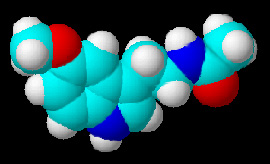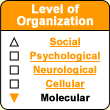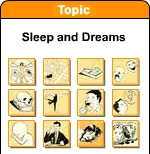|
|

Benzodiazepines are
a family of molecules, some of which are used as sleep-inducing
medications, while others are used as tranquillizers.
Benzodiazepines bind to a
specific site on a neuron’s receptor for GABA, a
neurotransmitter that counteracts the brain’s wakefulness
mechanisms. Thus benzodiazepines promote sleep by augmenting
this natural process.
The same GABAergic receptor also has binding sites that
can be used both by barbiturates (a class of drugs once
commonly used as sleep aids but now almost never used for
that purpose) and by anaesthetics, whose purpose is to
put surgical patients to sleep. |
|
|
| MOLECULES THAT BUILD UP AND MAKE YOU SLEEP |
|
As each day draws to a close, you feel the need to lie down and
go to sleep. The onset of sleep, which seems like such a simple
phenomenon from a behavioural
perspective, is actually quite complex from a molecular one.
In the early 20th century, French psychologist
Henri Piéron
hypothesized that prolonged wakefulness causes the build-up of
a “sleep toxin" that is subsequently broken down
during sleep. To test his hypothesis, Piéron walked
dogs through Paris at night to prevent them from sleeping. He then
injected their cerebrospinal
fluid into the brains of other dogs. He found that these other
dogs then slept longer and more deeply than usual.
We now know that the “hypnogenic” (sleep-inducing)
substances that Piéron hypothesized do in fact exist. Some
of them are small protein molecules that are produced by brain
structures such as the hypothalamus and that inhibit the neurons
of the wakefulness system.
But these proteins are not the only hypnogenic
molecules. The build-up of serotonin in certain
parts of the brain during periods of wakefulnessalso
contributes to the onset of sleep. The serotonin level in certain
areas of the brain also
affects mood. That is why some problems such as depression and anxiety often
lead to sleep disorders. People with low serotonin levels also
tend to spend less time in restorative non-REM
sleep over the course of the night.
| Serotonin also plays an
important role in sleep because the body uses it to synthesize melatonin.
Melatonin is produced at night and plays a fundamental role
in regulating the body’s biological clock. In fact, melatonin
governs the entire sleep/wake cycle, whereas serotonin is involved
more specifically in wakefulness, in triggering sleep, and
in REM
sleep. |
 Diagram of a melatonin
molecule
Diagram of a melatonin
molecule
(Atoms: pale blue = carbon, dark blue = nitrogen,
red = oxygen,
white = hydrogen) |
Thus sleep is triggered by two inter-related
processes: the production and build-up of hypnogenic substances
in the body while we are awake, and cyclical fluctuations in
substances such as melatonin that are associated with our body’s
biological clock.
Among the hypnogenic substances that build up while we are awake, adenosine,
has been the subject of much discussion since the mid-1990s.
|
|





